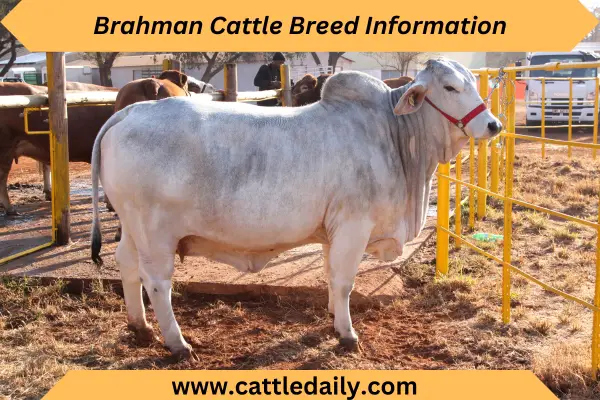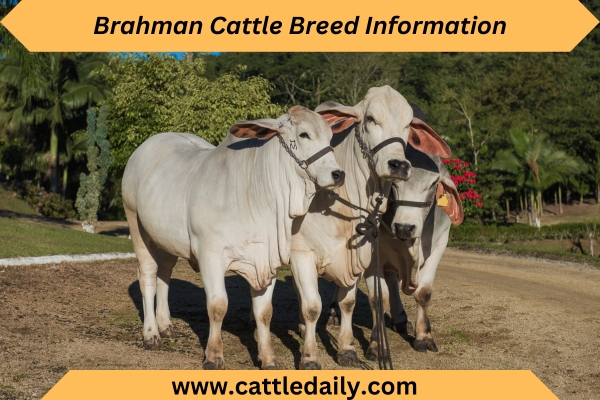Brahman Cattle Breed Information
The Brahman is one of the most popular cattle breeds in the world. This large breed of cattle originated in India and is known for its tolerance to heat, disease resistance, and excellent maternal abilities.
Origin of Brahman Cattle
The Brahman breed originated from the Bos indicus cattle that were brought to the United States from India in the early 1900s. These cattle were crossbred with different European breeds like the Shorthorn and Hereford to develop the American Brahman breed that we know today.
The name “Brahman” comes from the Hindu sacred scripts of ‘Vedas’, which described cattle as Brahman. These cattle were treasured in India and revered for their endurance in harsh conditions.
History
The first Brahman cattle in the US were imported to Texas in 1854 by James S. Wadsworth. Further imports of Indian cattle continued over the next several decades and were used to develop the Brahman breed.
The American Brahman Breeders Association was formed in 1924 to maintain the purity of the breed and promote its qualities.
Since then, the Brahman has spread across the southern states and has been used extensively in crossbreeding programs to produce breeds like Brangus, Beefmaster, and Simbrah.
Characteristics of Brahman Cattle
Brahman cattle have a distinctive physical appearance that sets them apart. Here are some of their unique characteristics:
Large Humped Back: The large hump between the shoulders is a distinctive feature of Brahmans. It contains metabolic brown fat that helps regulate body temperature. In cool weather, lower blood flow to the hump conserves heat.
In hot conditions, increased blood flow to the hump dissipates excess body heat by sweating and evaporation. This allows Brahmans to adapt to hot climates. The hump acts as a thermal window to maintain homeostasis.
Loose Skin: Brahmans have abundant loose, wrinkled skin around the neck. This excess skin provides more surface area for heat dissipation. Increased blood flow to the skin releases heat.
Sweat glands in the skin also soak the neck folds to aid evaporative cooling through sweating. The ample skin folds thus help Brahmans lower body temperature in hot weather.
Large Dewlap: The large pendulous dewlap is a fold of skin hanging from the throat and chest. Like the neck skin, it has thermoregulatory functions.
The huge dewlap flap provides an extra skin surface containing blood vessels and sweat glands to dissipate heat through convection, sweating and evaporation. More blood circulation to the dewlap also carries heat away from the body core when the animal is hot.
Ears: Brahman cattle have distinctive medium-sized ears that hang down the sides of the head. The large thin ears are well supplied with blood vessels. In hot conditions, increased blood flow to the ears releases heat by radiation and convection. The ample ear surface area thus contributes to thermal regulation.
Color: Brahman cattle occur in gray, red, and black coat colors. However, gray is the most common color. The short glossy coat reflects heat and solar radiation away from the body.
The coat also insulates the skin and is soaked with moisture from sweat glands to facilitate evaporative cooling.
Horns: Brahman bulls have characteristic horns that curve upwards and slightly backward. The horns provide protection and also act as heat radiators.
Blood circulation to the horns releases excess body heat when the animals are heat-stressed. The horn shape and position enable the Brahman to dissipate heat efficiently.
Average Weight: Mature Brahman bulls can weigh around 1,800 pounds while cows average around 1,000 pounds. The large body size provides ample surface area for heat dissipation and supports the thermal regulatory mechanisms like the hump, skin folds, horns, etc.
Heat Tolerance: The Brahman’s distinctive physical traits provide superior heat tolerance. The breed is well adapted to withstand hot, humid climates with minimal stress due to these anatomical adaptations.
Disease Resistance: Brahmans have strong resistance to parasites, insects, and diseases. They have immunity against ticks, worms, and other internal parasites. This gives the breed an added survival advantage.
Maternal Instinct: Brahman cows exhibit excellent maternal ability and produce good calves consistently. They have greater fertility with a longer breeding life than other cattle breeds. The cows are very protective of their young.

Uses of Brahman Cattle
The excellent adaptability of the Brahman makes them suitable for the following uses:
Beef Production: Brahmans are excellent beef producers due to their size, feed efficiency and carcass qualities. They produce tender, high-quality lean beef with minimal fat.
Brahman-influenced cattle dominate beef production in hot regions. Crossbred Brahmans yield profitable returns under range conditions.
Crossbreeding: Brahman bulls are used extensively in crossbreeding programs to impart hybrid vigor and desirable Brahman qualities like heat tolerance, disease resistance, tick immunity, and maternal ability to the offspring. Popular crosses include Brangus, Beefmaster, Santa Gertrudis, Simbrah etc.
Rodeos: Brahman bulls are a popular choice in rodeos and bucking events because of their agility, strength and temperament. They display excellent bucking ability. Their stamina and hardiness also support their use in rodeos.
Oxen: Brahman bullocks are trained as oxen for draft work as they are powerful and tolerant of hot climates. Their strength, stamina and ability to thrive on poor-quality forage make them well-suited as oxen.
Dairy Production: Some strains of Brahmans like the Red and Grey Brahmans produce good milk yields with moderate butterfat content.
Brahman crosses also produce profitable milk. However, on the whole, the breed is primarily used for beef production.
Care and Management of Brahman Cattle
Proper care and management are essential to keep Brahman cattle healthy and productive. Here are some tips:
Shelter: Provide clean, well-ventilated shade and shelter from extreme weather conditions. Ensure adequate airflow during hot weather to prevent heat stress.
Feed: Grass, hay, silage along with concentrates containing 12-14% protein. Feed good quality forage and 2-3% of body weight in balanced rations daily.
Water: Provide abundant clean, fresh water at all times. Have adequate, well-distributed watering points.
Health: Vaccinate against common diseases like anthrax, blackleg etc. Deworm and control external parasites regularly. Monitor for signs of illness.
Breeding: Brahman bulls can be used for breeding from 18-24 months of age after fitness evaluation. Check semen quality and test bulls for fertility.
Calving: Provide individual pens for calving cows. Monitor cows closely and assist with difficult births if required. Ensure calf nurses soon after birth.
Calf Care: Dehorn and castrate male calves early. Wean calves between 6-8 months of age. Ensure colostrum intake and provide creep feeding.
Exercise: Brahmans need sufficient exercise and grazing area. Rotate pastures and divide into paddocks to provide adequate forage.
Conclusion:
The Brahman is an economically important cattle breed valued for its remarkable heat tolerance, disease resistance, and maternal abilities that make it thrive under tropical conditions.
With proper care and management involving shade, balanced diet, breed improvement, and health care, Brahman cattle can be productive and profitable in beef and dairy production systems, especially in hot climates. The breed’s excellent qualities, most notably its ability to regulate body temperature, allow it to adapt and flourish in hot, humid environments. Learn here more about cattle breeds guide and information.


